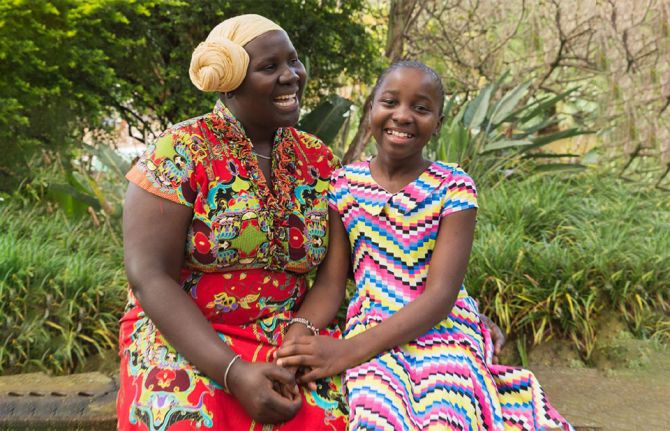
Feature Story
Data shows progress needed on HIV testing and treatment for children and mothers
30 ноября 2009
30 ноября 2009 30 ноября 2009NEW YORK/GENEVA/ BARCELONA 30 November 2009 – National efforts to combat AIDS, particularly by preventing mother-to-child transmission, are showing positive results, but many HIV and AIDS affected children still struggle to have their basic needs met, according to a report launched today by four United Nations agencies.
The report, titled Children and AIDS: The Fourth Stocktaking Report, 2009 and published jointly by UNAIDS, the UN Population Fund (UNFPA), UNICEF and the World Health Organization (WHO), features data on interventions that protect women and children from HIV and AIDS and a set of principles to guide accelerated action.
The data shows there has been significant progress in some countries in both treatment to avoid mother-to-child transmission and testing of pregnant women for HIV. Treatment to prevent mother-to-child transmission is now provided to 95 per cent of those in need in Botswana, 91 per cent in Namibia and 73 per cent in South Africa -- all countries with high HIV prevalence. Progress is particularly evident in South Africa, where coverage was risen from just 15 per cent in 2004.
“Globally, 45 per cent of HIV-positive pregnant women are now receiving treatment to prevent them passing HIV on to their children, an increase of nearly 200 per cent since 2005,” said Ann M. Veneman, UNICEF Executive Director. “The challenge is to scale up treatment in countries such as Nigeria, which is home to 15 per cent of the world’s pregnant women living with HIV.”
Children have a right to be born free from HIV. No cost is too high for saving mothers and babies. We can achieve this if we leverage the AIDS response to also strengthen maternal child health services. .
Michel Sidibé, UNAIDS Executive Director.
Currently only 10 per cent of women in Nigeria are tested for HIV and ninety percent of pregnant women living with HIV are not accessing treatments to prevent mother-to-child transmission.
The links among household poverty, maternal and child health, and HIV remain strong. However successes are evident where governments have made strong commitments to address maternal and child health – including HIV testing and treatment – and where testing and treatment have been incorporated into general maternal and child health programmes. Progress will be stronger if root causes of vulnerability to HIV, including poverty, gender inequality and sexual violence, are addressed.
"We cannot afford to be complacent," said Dr Margaret Chan, Director General of WHO. "In many high-income countries, paediatric HIV has been virtually eliminated. This shows what is possible. WHO's new recommendations on preventing mother-to-child transmission, launched today, offer an important opportunity to dramatically improve the health of mothers and children in low-income settings."
Globally pediatric treatment for HIV positive children, while still lagging behind adult treatment, has increased to cover 38 per cent of those in need -- an improvement of nearly 40 per cent in just one year. Recent evidence indicates that infant diagnosis in the first 2 months of life and early initiation of anti-retroviral treatment (ARV) can lead to significant reductions in child mortality, but the data shows that globally only 15 per cent of children born to HIV positive mothers are being tested in the first two months.
“To expand HIV testing for mothers and children, we need to tackle social barriers such as violence, stigma and discrimination, and strengthen health systems,” said Thoraya Ahmed Obaid, UNFPA Executive Director. “By providing integrated services for maternal and newborn healthcare and family planning and HIV testing, counseling and treatment, we can save and improve the lives of millions of women and children.” The situation of HIV and AIDS orphans continues to be a cause of concern, with only 1 in 8 families caring for orphans and vulnerable children receiving external help, such as medical care, financial assistance and support for education.
Another hard-hit group is women and girls aged 15 to 24. Women and girls in this age group in sub-Saharan Africa continue to account for nearly 70 per cent of all new infections among young people in the region. The report suggests that dealing with the epidemic’s drivers -- including sexual violence – means including men and boys in the response. "Children have a right to be born free from HIV," said Mr Michel Sidibé, UNAIDS Executive Director. "No cost is too high for saving mothers and babies. We can achieve this if we leverage the AIDS response to also strengthen maternal child health services."
The report shows that investments in HIV and AIDS prevention and treatment are paying off, especially for women and children. If they are sustained, and supported by commitment and sound policies, the dividends will be measured in lives saved.
The Stocktaking Report will be launched at 11:00 a.m. in the UN Secretariat on 30 November 2009, with special guest C. Virginia Fields, President and CEO of the National Black Leadership Commission on AIDS, Jimmy Kolker, UNICEF, Nathan Shaffer, WHO and Reshma Pattni, UNFPA.
Data shows progress needed on HIV testing and tre
Cosponsors:
Contact:
Kate Donovan,
UNICEF
Tel: 212 326 7452
E-mail: kdonovan@unicef.org
Richard Leonard,
UNAIDS
Tel: +1 646 666 8009
E-mail: LeonardR@unaids.org
Publications:
Children and AIDS: The Fourth Stocktaking Report, 2009 (pdf, 5.04 Mb.)
Children and AIDS: The Fourth Stocktaking Report Summary, 2009 (pdf, 782 Kb.)
Related
 Young role models combat HIV stigma in Central Asia
Young role models combat HIV stigma in Central Asia

22 июня 2023 года.
 United for ending cervical cancer, HIV and inequities for women and girls
United for ending cervical cancer, HIV and inequities for women and girls

17 ноября 2022 года.

